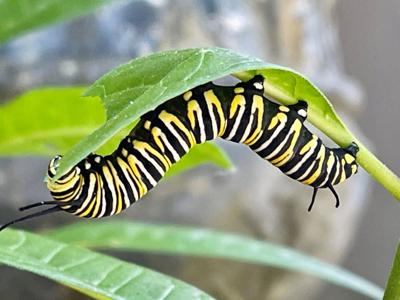Garden columnist Dan Gill answers readers' questions each week. To send a question, email Gill at [email protected].
I've appreciated and benefited from your gardening advice on many occasions through the years. I was deeply concerned, however, by your recent article on what to do about caterpillars in the garden. I was surprised and disappointed not to see a clear statement of their value. And a clear caution or at least limitation on what one should do against them. — Christina
Thank you for your thoughtful comments; I appreciate your input. I did not mean to portray all caterpillars as highly destructive and advocate their ruthless eradication. Caterpillars are part of the web of life and provide critical food for birds and predatory insects like wasps. And caterpillars grow up to be moths and butterflies, important pollinator insects.
Control efforts should be employed only when absolutely necessary to save a vegetable crop, a lawn or bedding plants in beds and containers from high levels of damage. When caterpillar damage is light, control is not critical. You can hold off, monitor the situation and control them only if the level of damage reaches the point where it becomes necessary.
Caterpillars in trees and shrubs do not need to be controlled in most situations. As I mentioned in my column, trees and shrubs will recover even from heavy caterpillar damage to their foliage. When control is needed, the least toxic and environmentally friendly methods are preferred.
Hand-picking works well on a few plants and light infestations (although caterpillars can hide very well and many feed at night when they would be hard to see). Organic insecticide options like spinosad or BT are good choices if spraying is necessary.
Is there any way to kill crabgrass in St. Augustine this time of year? Thanks. — Kathy
Unfortunately, I don't know of any effective selective weed killer that will destroy growing crabgrass without hurting the St. Augustinegrass.
Like most weeds, crabgrass is most likely to occur in thin lawn areas where the turf provides little competition for space. So, make sure lawns are as thick and healthy as possible during the growing season through correct irrigation, fertilization and mowing.
You can physically remove the crabgrass, but that is labor-intensive and may not be a good option for many gardeners. You can spot-treat with a nonselective herbicide that will kill the St. Augustine along with the weed. Glyphosate (Killzall, Eraser Grass and Weed Killer) is a commonly available choice.
This should be carefully applied only to the crabgrass plants, getting as little as possible on the surrounding lawn grass. This may kill an unacceptable amount of the turf grass, however, depending on the situation and how much damage to the lawn you are willing to accept and repair.
While not a solution for your current situation, our best option is to prevent crabgrass to begin with. This can be accomplished with a preemergence herbicide applied early next spring. Crabgrass is a warm-season annual. It dies out completely over the winter and reappears in the spring from germinating seeds. Keep the seeds from germinating, and you will see less or no crabgrass in your summer lawn.
The timing of applying these preemergence herbicides (weed preventers) is important. They must be applied before the crabgrass seeds begin to germinate. In our area, applications should be made in February (if the winter is mild, early February).
Products that may be used include Sta-Green Crab-EX, Greenlight Crabgrass Preventer 2, Hi-Yield Turf & Ornamental Weed and Grass Stopper, Greenlight Crabgrass Preventer and Scotts Halts Crabgrass Preventer. These are granular products spread over the lawn like fertilizer following package directions. They will also control a variety of other warm-season weeds that germinate in the spring.

Fig fruit ripens on the tree.
Garden tips
CAUTION: Fig harvesting begins in mid-to late June and kicks into high gear in July. Be careful when harvesting or pruning figs. Special cells in the plant produce a latex that contains ficin. Contact causes ficin dermatitis in people who are sensitive. Psoralens in the fig sap are activated by sunlight and cause dermatitis in sensitive people as well. Wear long sleeves and gloves when working with or harvesting figs, avoid getting sap on your skin and wash it off promptly if you do.
VEGGIES NOW: Heat-tolerant vegetables to plant in July include cantaloupe, cucumbers, luffa, okra, hot and sweet peppers, pumpkins, Southern peas, squashes and watermelons. Plant tomato and bell pepper seeds in mid-to late July in pots or cell packs to produce transplants for planting in August, or just wait for transplants to become available at that time in area nurseries.
A LITTLE TLC: Keep colorful flowerbeds well-groomed and weed-free. Remember that they are highly visible in the landscape. Try to deadhead as regularly as possible to encourage continued flowering.
HOT COLOR: For late-summer color, continue to plant heat-tolerant bedding plants. Excellent choices for sunny areas include angelonia, coleus, torenia, periwinkle, melampodium, salvia, scaevola, purslane, pentas, blue daze, lantana and verbena. In part shade plant caladium, impatiens, begonia, torenia and coleus.
MOWING METRICS: Mow regularly. It is unhealthy for lawn grass if you allow it to get too tall and then cut it back short. Try to mow frequently enough so that you remove no more than one-third of the length of the leaf blades when you mow.



